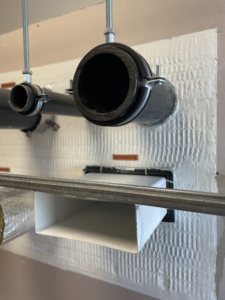Plastic pipes vs plastic ducts – is test evidence transferable? Firestopping FAQs
It is a common misconception that test evidence for plastic pipes can also be used for plastic ducts.
However, despite their similar appearance and material makeup, these two products are used for different applications and, therefore, rely on specific test evidence.
In this article, we will explain the difference between plastic ducts and plastic pipes. We will also explain why you cannot transfer test evidence, ensuring compliance and life safety in the event of a fire emergency.
So – plastic pipes.
Plastic pipes are circular in shape and used to carry water or waste. To effectively firestop them, an intumescent fire collar or fire wrap would be installed to maintain the building’s compartmentation, following test evidence and manufacturer guidance.
In a fire, the intumescent material in the fire collar or fire wrap* will expand. This happens as the plastic pipe melts, sealing the gap left behind.
*A fire sleeve or HPE sealant may also be suitable, depending on the test evidence.
While plastic vent ducts work in a similar way, they are usually rectangular and used for ventilation, although circular options are also available.
The key point about plastic pipes and ducts is that they don’t behave the same way in a fire; therefore, they require specific firestopping products and systems tailored to the particular size and shape of the pipe or duct.
Only tested firestopping solutions should be used, highlighting the importance of understanding your specific application.
Why can’t solutions for plastic pipes transfer to plastic vent ducts?
Plastic soil pipes generally have a thicker wall compared to plastic ventilation ducts, which causes them to behave differently in fire situations.

Furthermore, plastic soil pipes are tested with one or both ends capped (C/U, C/C, or U/C) to simulate real-life scenarios, such as toilet traps. In contrast, plastic ventilation ducts are tested with both ends uncapped (U/U).
This testing method is more challenging because it allows heat and flames to pass directly through the duct, causing it to melt and collapse much faster than a soil pipe.
Metal ducts are treated differently because they have their own standard, whereas plastic ducts and plastic pipes are considered the same from a fire testing perspective.
However, due to the differences mentioned above, specific fire test evidence is still needed.
Ultimately, it’s the installer’s responsibility to make sure the product is suitable for the job. Even the smallest details can make a difference when it comes to protecting people and property.
Therefore, it’s important to understand the differences between products, prioritise tested solutions, and reach out for guidance if you’re unsure.

